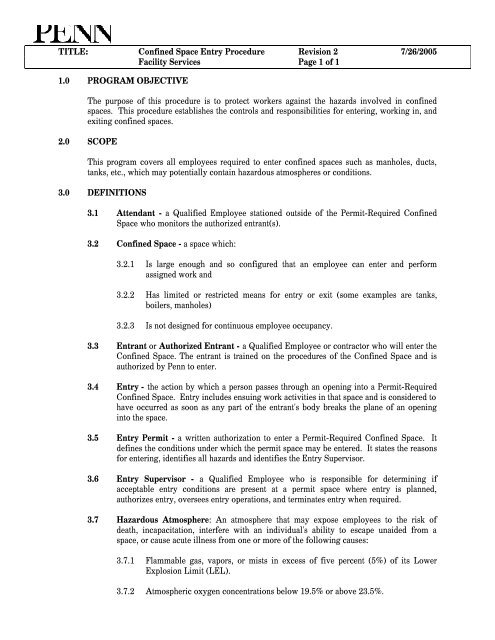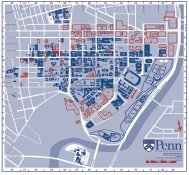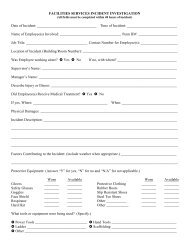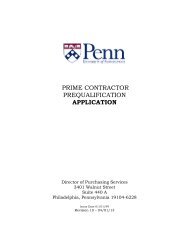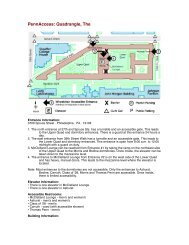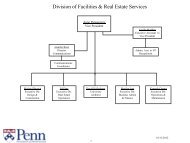TITLE: Confined Space Entry Procedure Revision 2 7/26/2005 ...
TITLE: Confined Space Entry Procedure Revision 2 7/26/2005 ...
TITLE: Confined Space Entry Procedure Revision 2 7/26/2005 ...
Create successful ePaper yourself
Turn your PDF publications into a flip-book with our unique Google optimized e-Paper software.
<strong>TITLE</strong>: <strong>Confined</strong> <strong>Space</strong> <strong>Entry</strong> <strong>Procedure</strong> <strong>Revision</strong> 2 7/<strong>26</strong>/<strong>2005</strong>Facility Services Page 11 of 11Approved By:Director of Central ServicesEffective DateUtilities Operations Manager
JOB PLANNING MEETINGAppendix ACONFINED SPACE ENTRY PROCEDURE1) Prior to entry into a confined space, personnel involved with the job will discuss the procedures that will be followed,so that the confined space work will be completed safely. The required equipment will be assembled; instructionswill be conveyed to those involved in the entry; procedures will be discussed; and hazards, which may beencountered, will be explained. The attendant should ensure that any ignition source taken into the confined space islimited to ones required to perform the necessary work. Each location may have different hazards.2) All necessary equipment to be used for entry will be assembled by the attendant, including communication devices(radios, if required) to be used to quickly summon Rescue PersonnelENTRY PROCEDURE1) Follow Penn’s Lockout/Tagout procedures to isolate any potential hazardous sources, which will adversely affectthose working in confined space.2) Open sufficient manhole covers, doors, vents, or other openings in the confined space.3) Where necessary, use ventilators to change the air in the confined space.4) A Qualified Employee will test the air for oxygen content, flammable and toxic gases (See Section 6.2). Initial airmonitoring data will be recorded on the confined space permit. (See Attached <strong>Confined</strong> <strong>Space</strong> Permit)a) Oxygen must be between 19.5% and 23.5%b) Flammable/Explosive gases must be below 5% Lower Explosive Limit (LEL)c) Toxic gases/vapors must be below OSHA’s Permissible Exposure Limits5) The <strong>Entry</strong> Supervisor will assign a trained Attendant to control entry into the confined space.6) The Attendant will ensure that all Entrants are authorized; keep an accurate count of all who enter; continuallycommunicate with those within the confined space; watch out for the well-being and safety of all entrants; and stayuntil relieved. Attendants will verify that all Entrants sign the Permit prior to entry.7) If all is clear in step 6, the <strong>Entry</strong> Supervisor will authorize entry. Continuous forced ventilation should be used whenrequired. Continuous air monitoring shall be conducted and recorded periodically on the back of the permit whenrequired.8) If work is stopped for any reason, the air tests shall be re-taken if deemed necessary by the <strong>Entry</strong> Supervisor, prior tore-entry.9) When the job has been completed, the Attendant will account for all Entrants before they leave the job site.10) The <strong>Entry</strong> Supervisor will check to ensure that all personnel are out, all equipment is clear, and when he is satisfiedwith the site conditions, he/she can close out the confined space entry permit, prior to allowing the <strong>Confined</strong> <strong>Space</strong> tobe sealed.
Appendix BALTERNATI VE ENTRY PROCEDURESThis Appendix lists the alternative entry procedures. It may be used as a checklist when permit space entry bythe alternative procedures is allowed. The signature of the employer's representative verifies that the space issafe for entry. This certification shall be made before entry and shall be available to each employee enteringthe space.Alternative entry procedures may be used in the following circumstances. The only hazard posed by thepermit space is an actual or potential hazardous atmosphere. The employer can demonstrate that continuousforced air ventilation alone is sufficient to maintain the permit space safe for entry, and the employer developsmonitoring and inspection data that supports the demonstration that continuous forced air ventilation alone issufficient to maintain the permit space safe for entry.Pe rmit <strong>Space</strong> L oca tion: Da te :1. Elimina te any conditions ma king it unsa fe to re move an entr anc e cover . List the haz ards andpr ec autions:2. When the entra nce c ove rs ar e removed, promptly guard the entra nc e to pre ve nt ac cidentalfa lls thr ough the opening a nd to protec t the entr ants from for eign objec ts. De scr ibe the guar dsto be e re cte d:3. Be fore an employe e enter s the spac e, te st the internal atmosphere f or the following conditions,in the or der give n, and rec or d below. List the a cce ptable range for the pote ntial toxic aircontamina nts.Ac ce pta ble RangeOxygen Conte nt: 19.5% to 23.5%Flammable Ga s and V apors:0% to 5% LELToxic A ir Contamina nts ( ): 0 to4. Pr ovide c ontinuous for ce d a ir ve ntila tion as follows:• An e mployee ma y not ente r the spac e until the f or ced a ir ve ntila tion has e liminate d anyha za rdous atmospher e.• Forc ed ve ntila tion is so dire cte d as to ve ntila te the immediate are as wher e a n employee is orwill be present w ithin the space a nd shall c ontinue until a ll employe es ha ve le ft the spa ce.• The air supply for the f orc ed air ventilation is from a c le an sourc e and does not incre ase theha za rds in the spac e.5. Continuous monitoring will be conducted. E mployee s must e va cua te the spa ce if the oxyge ncontent drops below 19.5%, the f la mma ble gas or vapor conce ntr ation is a t or above 5% of theLE L, and the toxic gases or vapor conce ntr ation e xce eds 50% of the PE L.6. If a ha za rdous atmospher e is detec ted during entr y, ea ch employe e sha ll le ave the spaceimme dia te ly; the space shall be evaluated to de te rmine how the haza rdous a tmospher ede ve loped; a nd me asure s sha ll be implemented to protec t e mployee s f rom the ha za rdousatmospher e bef ore a ny subse quent e ntr y takes plac e.I, _________________________________, c er tif y tha t the se pr oc edure s have bee n f ollow ed and tha t the c onf inedspac e is saf e for e ntr y.Entr y Supervisor:Signatur eDa te
CONFINEDSPACELOCATIONSteam ManholesElectricalManholesPENNAttachment A<strong>Confined</strong> <strong>Space</strong> InventoryDESCRIPTION HAZARDS SPACE LABELED SAFETYREQUIRMENTS / PPEPits containingsteam linePits containingelectrical linesAtmosphericHigh Pressure SteamHeat StressAtmosphericElectricalHeat StressCaution<strong>Confined</strong> <strong>Space</strong>Permit RequiredCaution<strong>Confined</strong> <strong>Space</strong>Permit RequiredFollow <strong>Confined</strong> <strong>Space</strong><strong>Entry</strong> Permit <strong>Procedure</strong>Lockout/TagoutFollow <strong>Confined</strong> <strong>Space</strong><strong>Entry</strong> Permit <strong>Procedure</strong>Lockout/TagoutAir Handling Without Energy Mechanical No Lockout/TagoutUnitsrecovery unitsAir HandlingUnitsWith EnergyRecovery UnitsChemical/RadiologicalDangerDo Not EnterFollow specific unit’s entryprocedure(BRB2/3, Johnson,CRB, StellarChance, Rosenthal)MechanicalFollow Service<strong>Procedure</strong>MOD 6 ICE TANK PIT Asphyxiation DangerPermit Required<strong>Confined</strong> <strong>Space</strong>Do not enterSump Pit Atmospheric Lockout TagoutFollow <strong>Confined</strong> <strong>Space</strong><strong>Entry</strong> Permit <strong>Procedure</strong>
CONFINED SPACE ENTRY PERMITI. ENTRY DESCRIPTION(Complete Prior to <strong>Entry</strong>)<strong>Confined</strong> <strong>Space</strong> Location /Number:Purpose of <strong>Entry</strong>:Date Permit Issued_________Time of <strong>Entry</strong>: (in) (out) Permit ExpiresAny equipment in need of repairs must be reported to the supervisor who will take proper steps to have repairs madeimmediately.II. ENTRY TEAM MEMBERSName (list below) Time In Time outAttendant xxxxxxxx xxxxxxxxEntrantEntrantEntrantEntrantIII. ATMOSPHERIC TESTINGHas unit been calibrated within last month Yes/No Battery checked? Yes/NoLocation inspace% O2 % LEL CO ppm Other Initials of TesterPrior to <strong>Entry</strong>*
At OpeningMiddleBottomAcceptableLimits*19.5-23.5% Below 5% Below 25 ppm*Continuous monitoring may be required. Site-specific conditions may require entrant to wear a monitor.**Contact EHRS 215-898-4453 if any reading exceeds acceptable limitIV. SAFETY CHECKLIST (check each item when completed)______1. Establish communication from worksite with OCC or PENNCOM (Emergency: dial 215-573-3333)______2. Barricades in position______3. Establish continuous ventilation/monitoring if required.______4. Communication checked between entrants and attendant (List how______________________)______5. Escape harness, tripod and winch available______6. Lockout/tag out completed (if needed)______7. Appropriate PPE worn_____Harness ______Hardhat _____ Gloves______Hearing Protection ___ Foot__________Personal Monitor ____Eye Protection ____Other (list)_______________________8. Lighting______9. Heat conditions assessed_____10. Others (list) _____________________________________________________V. AUTHORIZATION FOR ENTRY<strong>Entry</strong> Supervisor (print)___________________Signature _______________________Date_____________OR: <strong>Entry</strong> into this confined space can be completed using Alternative Method <strong>Procedure</strong>s:<strong>Entry</strong> Supervisor (print)___________________Signature _______________________Date____________OR: The above confined space has been reclassified to Non Permit Required:<strong>Entry</strong> Supervisor (print)___________________Signature _______________________Date____________MANAGER MUST RETAIN THIS FORM FOR ONE (1) YEAR FROM DATE OF ISSUE


